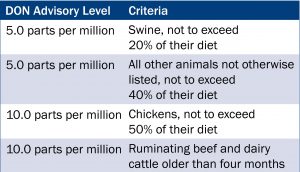Background: Deoxynivalenol (DON) or Vomitoxin
 DON is another mycotoxin of concern to some importers of corn. It is produced by certain species of Fusarium, the most important of which is Fusarium graminearum (Gibberellazeae), which also causes Gibberella ear rot (or red ear rot). Gibberellazeae can develop when cool or moderate temperatures and wet weather occur at flowering. The fungus grows down the silks into the ear. In addition to producing DON, it produces conspicuous red discoloration of kernels on the ear. The fungus can also continue to grow and rot ears when corn is left standing in the field. Mycotoxin contamination of corn caused by Gibberellazeae is often associated with excessive postponement of harvest or storage of high-moisture corn.
DON is another mycotoxin of concern to some importers of corn. It is produced by certain species of Fusarium, the most important of which is Fusarium graminearum (Gibberellazeae), which also causes Gibberella ear rot (or red ear rot). Gibberellazeae can develop when cool or moderate temperatures and wet weather occur at flowering. The fungus grows down the silks into the ear. In addition to producing DON, it produces conspicuous red discoloration of kernels on the ear. The fungus can also continue to grow and rot ears when corn is left standing in the field. Mycotoxin contamination of corn caused by Gibberellazeae is often associated with excessive postponement of harvest or storage of high-moisture corn.
DON is mostly a concern with monogastric animals, where it may irritate the mouth and throat. As a result, the animals may eventually refuse to eat the DON-contaminated corn and may have low weight gain, diarrhea, lethargy and intestinal hemorrhaging. It may cause suppression of the immune system, resulting in susceptibility to several infectious diseases.
The FDA has issued advisory levels for DON.
FGIS is not required to test for DON on corn bound for export markets but will perform either a qualitative or quantitative test for DON at the buyer’s request.
